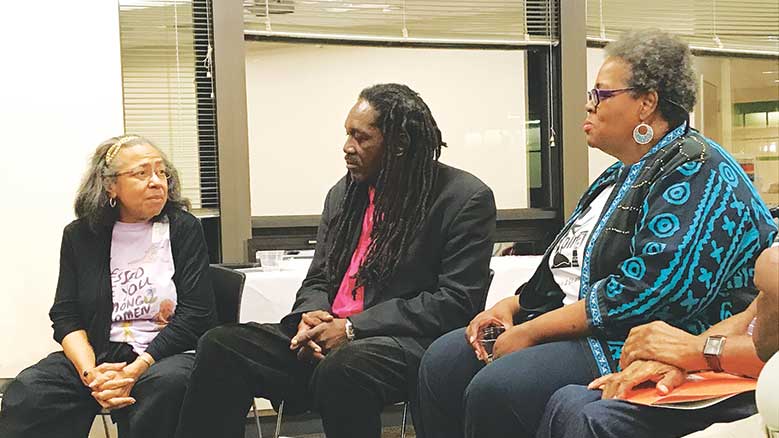
“We are seekers but we are also the holders of a precious heritage of discoveries. We, like every generation, must find the Light and Life again for ourselves. Only what we have valued and truly made our own, not by assertion but by lives of faithful commitment, can we hand on to the future. Even then we must humbly acknowledge that our vision of truth will again and again be amended.” —Quaker Faith and Practice, Britain Yearly Meeting, 1994
At an international level, the Religious Society of Friends is racially diverse. According to the map that Friends World Committee for Consultation published in 2017, of the 377,557 Quakers in the world, 181,405 live in Africa; 58,673 live in the Caribbean and Latin America; and 21,096 live in Asia-West Pacific (with Aotearoa/New Zealand and Australia not counted). I would consider the majority of the Friends in those regions to be people of color. We know that there are Friends of color in Aotearoa/New Zealand, Australia, Canada, Europe, and the United States, but I cannot include their numbers because of our color-blind practice of not recording the race and ethnicity of our membership. It’s important for us to be able to document the number of people of color in our meetings. When people ask me how many people of color are members of the Religious Society of Friends in the United States, I have to say, “I honestly do not know because we do not acquire that information.” I encourage our monthly and yearly meetings to change that practice and begin keeping track of how many people of color are members and attenders of our meetings.
The lack of racial diversity within the Religious Society of Friends in the United States of America is not a new concern. The Friends Review published an article in their July 20, 1850, issue that said:
It is a remarkable circumstance, that although the members of our religious society have been so long and so extensively known as the advocates of the coloured race, and the discipline established among us presents no impediment to their reception into membership . . . still the number of coloured persons found within the society has always been exceedingly small. This circumstance may justly raise the enquiry whether the cause lies with them or with us. Is the religion of Friends unsuited to the coloured race? Or are they kept at a distance by our neglect or repulsive conduct?
My answer to the author’s question is that we are kept at a distance by the repulsive conduct. Our history frames our present. People of color have been treated unequally within the Religious Society of Friends since it was brought to this country. My research with Donna McDaniel for our 2009 book, Fit for Freedom, Not for Friendship: Quakers, African Americans, and the Myth of Racial Justice, illustrated those practices to me. People of African descent have struggled to be treated as equal members of the Religious Society of Friends since the 1600s. African American Friends have been speaking out about our experiences of white supremacy within Quakerism for centuries.
Elmyra (Amhara) Powell, an African American former member of Pasadena (Calif.) Meeting, in the October 2003 issue of Friends Journal wrote her understanding of this situation in her article titled “Discovering Fellowship among African American Friends.”
I began researching African Americans in relation to the history of Quakerism in the U.S. I found Henry Joel Cadbury’s 1936 article, “Negro Membership in the Society of Friends,” from the Journal of Negro History . . . After reading it several times, I came to understand the dearth of African American Quakers today as an outgrowth of prior patterns of racial exclusivity that Quakers and most other European American religions shared at the time, but which other denominations, unlike Quakers, offset later by subsequent evangelistic efforts focused on the black community. I concluded that there was nothing Quakerly or even natural about the overwhelming whiteness of Quakerism in the United States. It was historically created by artificial means, and it has simply gone without an effective historical corrective.
None of these meetings exist today. Why did they die out? Friends decided there were enough other congregations providing religious services for people of African descent that they could lay down their meetings.
What were some of those patterns that Amhara and I had noticed? The first and foremost practice among Friends was enslaving people of African descent. The next was Friends’ establishment of regular meetings for worship for people of African descent who they enslaved in 1675 in the West Indies. Friends felt they were providing separate and equal opportunities for people of African descent to worship among their own kind. All of these meetings were overseen by Friends of European descent. Cadbury in his article “Negro Membership in the Society of Friends” stated that William Penn created separate regular meetings for worship for people of African descent in 1700 in Philadelphia. North Carolina Yearly Meeting established regular meetings for worship for African Americans in 1758 at four different locations, as did Flushing (N.Y.) Meeting in 1784. In Haddonfield, New Jersey, a meeting was established that had almost 200 people of African descent attending in 1799, reported by Kenneth Ives in his book Black Quakers: Brief Biographies. None of these meetings exist today. Why did they die out? Friends decided there were enough other congregations providing religious services for people of African descent that they could lay down their meetings. The intent of those meetings was not to open the doors of Quakerism to people of African descent but to provide religious instruction.
Initially Africans and people of African descent were not allowed to become members of the Religious Society of Friends. This custom was established to keep people of African descent from having the freedom to marry Friends of European descent. Historian Gary Nash in his book Forging Freedom: The Formation of Philadelphia’s Black Community, 1720–1840 wrote:
Quakers’ strong fear of interracial mingling burst into the open in 1795, when Hannah Burrows, “a light-skinned woman,” who frequently attended meeting, sought membership in a Philadelphia Friends meeting. “The chief objection,” revealed Joseph Drinker, a leading Quaker, was that if membership was granted, “the privilege of intermarriage with the whites could not be withheld” and “‘such mixtures are objectionable.”
According to the information I have been able to find, Abigail Franks, was one of the first African Americans to be permitted to join the Religious Society of Friends in the Philadelphia area. According to Cadbury in his article “Negro Membership in the Society of Friends,” she applied for membership in Birmingham (Pa.) Preparative Meeting in 1781. The meeting was not able to decide if it was appropriate to admit her into membership, so they referred her application to their monthly meeting, Concord, which wasn’t able to decide either, so they referred it to the quarterly meeting. The quarterly meeting had the same concern. They appointed a committee to meet with Franks. The committee found: “her disposition they apprehended to be worthy of Friends’ notice; and her color appeared to them not darker than some who are esteemed white.” Even after the visit they were not able to decide about her membership, so they sent the request to Philadelphia Yearly Meeting in 1783. There was doubt regarding her membership even on the yearly meeting level. However, the committee reviewing the application for the yearly meeting reported to the meeting:
It is the sense and judgment of the meeting that Concord Monthly Meeting may safely consider the application of the person on the same ground in common with other applications for admission into membership.
So, in May 1784, Franks was accepted into membership three years after her original application. Thomas Drake in his book Quakers and Slavery stated that in 1790, after lengthy consideration a statement was incorporated into Philadelphia Yearly Meeting’s Discipline that “Meetings are at liberty to receive such [convinced persons] into membership, without respect of nation or color.” Cadbury reported that despite the yearly meeting’s decision, Cynthia Miers, when applying to Rahway and Plainfield (N.J.) Meeting in 1796 (then a part of Philadelphia Yearly Meeting), went through the same process as had Franks. When her application arrived at the yearly meeting, they reported: “We are united in believing our Discipline already established relative to receiving persons into membership is not limited with respect to Nations or Colour.”
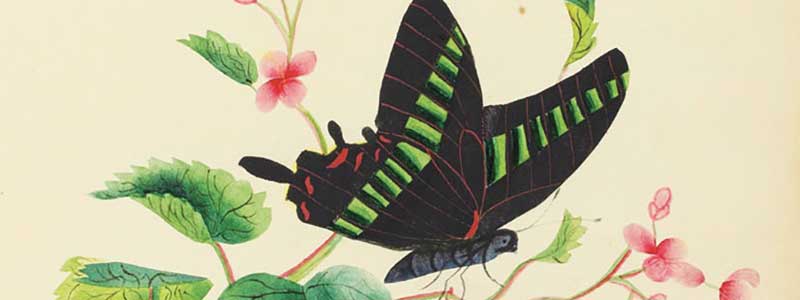
Sarah Mapps Douglass shared her feelings that it was unchristian to take away the freedom of choice from African Americans in a house of worship.
After a few people of African descent joined Quakerism, they found another barrier to equal treatment. Often worship took place in separate meetinghouses, or if they were invited to worship in a meetinghouse with people of European descent, they were placed in segregated sections, thus following the customary practice of all other religions during that time period.
The first Friend of color on record whom I know of to have spoken out about her unequal treatment within Quakerism was Sarah Mapps Douglass, an African American educator; scholar; artist; abolitionist; and attender, along with her mother, of Quaker meeting in Philadelphia. She wrote about her mother’s experience of being told not to apply for membership. Douglass spoke out about her pain caused by the establishing and maintaining of separate sections within the meetinghouse.
On December 14, 1843, Douglass wrote a letter that was published in the National Anti-Slavery Standard. In her piece, she shared her feelings that it was unchristian to take away the freedom of choice from African Americans in a house of worship. She also shared her mother’s belief that this practice kept African Americans away from Quakerism.
I have frequently heard my mother say that very many of our people inclined to Friends’ mode of worship; she lamented the unchristian conduct that kept them out. Some have gone out from “Friends,” not because they prefer their own meetings, where they regularly hear “singing and preaching” but because they could not bear the cross of sitting on the “black bench.” Ah, there are many poor stray starving sheep, wandering in this world’s wilderness, who would gladly come into your green pastures, and repose them by your still waters; did not prejudice bar the entrance! I am persuaded the Lord has controversy with “Friends” on this account. Let them see to it.
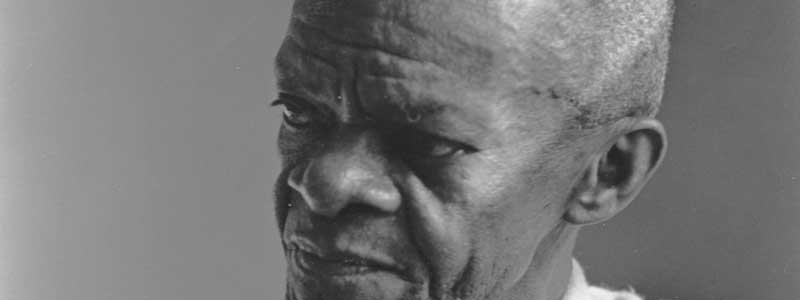
[Friends] have not been able to act forcefully for civil rights for fear of losing social status and incurring the disfavor of their neighbors.
Unfortunately, Friends have not “see[n] to it.” In the twentieth century, African American Friends continued to speak out about the pain we experience as members of the Religious Society of Friends. Barrington Dunbar who was a member of 57th Street Meeting in Chicago, Illinois, spoke out at a time when the Civil Rights Movement was transforming into a struggle for self-governance. This was a time when African Americans were very distrustful of people of European descent, especially those involved in a religion. Christianity was and is seen as the tool used to enslave and colonize people of color. For centuries European American Quakers have treated African Americans as if they were unable to make good decisions about their lives. Now African Americans are focusing on self-determination by demanding the right to make their own decisions about their lives. In the essay “Quaker Response to Racial Crisis” written by Dunbar for a 1969 book published by Friends World Committee for Consultation on themes that engrossed their 1967 Triennial at Guilford College, he addressed racial justice:
A revolution of great magnitude is in progress in the United States. What has been the response of the Society of Friends to this revolution? For the most part, the members of the Society of Friends have been content to be “white liberals.” Though they have advocated marginal reforms, they have accepted the American system, the legitimacy of its basic values and institutions. They have accommodated to the poor housing, inadequate schools, and squalor in ghettos adjacent to their suburban communities. But they have not been able to act forcefully for civil rights for fear of losing social status and incurring the disfavor of their neighbors. Conformity has been a dead weight around their necks.
Living thus, Friends have not experienced the degradation and frustration inherent in the total experience of black people in America; and they fail to understand Black Power, which they equate with arrogance, violence, and separateness. . . . It is with respect to the question of violence as advocated by some ultra-nationalists that Friends have found Black Power most objectionable. . . . Institutional racism in America is covert violence—the day to day violence that has been perpetuated by white on black Americans for over three hundred years. Friends have accommodated to it. They have lost their “revolutionary faithfulness” . . . and have unwittingly become allies in maintaining a violent society. We Friends are therefore guilty of our kind of violence.
This essay shows his frustration and disappointment with Friends and their attitudes toward racial justice and fear of the Black Power Movement. Almost 40 years later, Bill Brown is also frustrated with Friends’ level of involvement in racial justice. People of African descent are still struggling for equality within Quakerism and the society at large. Brown, an attender from West Falmouth Preparative Meeting under the care of Sandwich (Mass.) Meeting, in his article “What Do Quakers Owe Blacks” says:
I do not expect a racial epiphany that will reveal us as people. Without a doubt, the subject of racism is emotional. Therefore, I expect that Quakers will have the emotional and spiritual strength not to tell me that race is not a part of Quaker consciousness. . . . I am caught in the dilemma of trying to be a loving and trusting Quaker in a religious home that seems not to understand my most foundational needs: shelter in a perilous time, comfort from the cyclical cause-and-effect relationship of class and color, and a stable location in the human family.
Quakers may not have slandered, persecuted, or denounced blacks, but there was a coziness with racism that was certainly within the pivotal degrees of cooperation with the status quo. Racism is a virus that quietly lurks in the Society of Friends.
James Fletcher in his article titled “A Quaker Speaks from the Black Experience,” printed in the January 2007 of Friends Journal wrote:
When I was considering becoming a member of the Religious Society of Friends, I had read deeply of the writings of early Friends, and attended Wilton (Conn.) Meeting, which then had Bob Leslie as its clerk. Bob was wonderful at outreach. With fruitful persistence, he helped me overcome my delays in attending meeting.
But I still had a major “stop in my mind” about becoming a member of the meeting. The Civil Rights Movement, though beyond its high point, was still a potent force, and another round of race riots had recently transpired. I did not want my becoming a member of the Religious Society of Friends to compromise my identity as an aware, black U.S. citizen, fully committed to the freedom and liberation struggles of black people worldwide. I also felt that the Friends Peace Testimony would constrain me to be on the sidelines rather than at the forefront in this fight.
Barrington Dunbar was so central in my life then because when I read his words, it was clear that he was a black Friend in good standing who was not himself constrained in the ways I feared I could be. He was one who could “speak to my condition” by writing forcefully about concerns that were near and dear to my heart, but which I did not feel were uppermost in the hearts and minds of white Friends I knew.
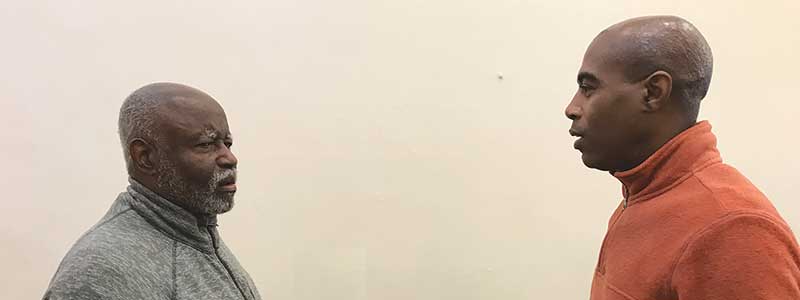
If we want to have a truly racially diverse Religious Society of Friends, we need to stop assuming that the painful experiences African American Friends have shared are isolated incidents.
I have shared some of the words of Friends of African descent telling Friends of their unequal treatment within Quakerism and their lack of prioritizing our liberation from white supremacy in our meetings and the society at large. If we want to have a truly racially diverse Religious Society of Friends, we need to stop assuming that the painful experiences African American Friends have shared are isolated incidents and see the patterns that have created barriers to membership for us. Our meetings are a part of our white supremacist society, and, as so, reflect the expectation for people of color to assimilate to the white dominant norms of our meetings and society.
In the October 2014 issue of Friends Journal, Dwight L. Wilson in his article titled “The Social Justice Testimony” wrote:
Friends recognize ours is a racist society, with one foundation block being the theft of millions of blacks who were placed in perpetual slavery and another the theft of Indian land and then the demonization of the victims. Still, rare is the Quaker meeting that asks applicants for membership about personal racism. Joining a meeting does not purify a person of racism.
What happened to the Religious Society of Friends that we could choose to hide our passions? One of our standing jokes may supply the answer: They came to do good and did quite well. Yes, personal perspectives on justice have been known to change with one’s degree of comfort. In response to this phenomenon, the eighteenth-century Quaker John Woolman offered guidance when he said, “Oppression in the extreme appears terrible, but oppression in more refined appearances remains oppression, and where the smallest degree of it is cherished it grows stronger and more extensive.” Without social justice, there is no peace. That is a hard lesson.
Paul Ricketts, a former member of Fort Wayne (Ind.) Meeting, shared in his article “Move in Our Midst,” published in the March 2017 Friends Journal:
The call to justice, like the call to discipleship, is never easy. Living in the tension between a faith that is deeply rooted in the sovereignty of the One in whom we live and move and have our being, and a faith whose roots are deeply intertwined with white supremacy is very disheartening. . . . In dismantling these stumbling blocks, we must tap into the power of the Spirit while acknowledging the truth that structural oppression and systemic racism does spiritual violence to us all. To be faithful in this time, we must do more than admit that such oppression and attitudes of privilege exist. We must act to eliminate them if we wish to be fully inclusive in ways that are more than mere words.
Sadly, this past summer…I was distressed to learn that several African American Quakers had left their meetings. They are no longer able to tolerate the racism they experience on a weekly basis in their local meeting.
The first step in changing those behaviors requires us to have an awareness of them and their impacts. Our past is not divorced from the present; we cannot fully understand and adequately respond to the racial injustices of the present without understanding racial injustices of the past. Many times, the racial discrimination or exploitation of the present is not a new creation but rather a redesigned extension of oppressive structures and beliefs of the past. I know there are some Friends that have begun to address white supremacy within their meetings. Central Philadelphia is one of them. We need more meetings to understand that no matter how progressive you see yourselves, you are a part of the United States of America and as such have white supremacy sewn into your community.
Sadly, this past summer, during the Friends General Conference’s Pre-Gathering Retreat for People of Color and Their Families held in Toledo, Ohio, I was distressed to learn that several African American Quakers had left their meetings. They are no longer able to tolerate the racism they experience on a weekly basis in their local meeting. I watched their spirits revive as we spent time together sharing our experiences of isolation, marginalization, and our joy for finding a home in Quakerism with each other. Our souls began to heal with the spiritual salve of spending time with one another.
Given our current political climate and the increased stress that it has brought into all our lives, it is especially important for some people of color in majority white religions to spend time together. It is important for our meetings to provide opportunities for people of color to meet by ourselves, to replenish our souls. Science has proved that white supremacy takes a tremendous toll on our emotional, physical, and spiritual beings. For many people of color spending time together helps heal some of the trauma we are experiencing. Our times together in meetings and retreats may make some people feel uncomfortable. It is a discomfort that I am going to ask those of you for whom this is true to live with.
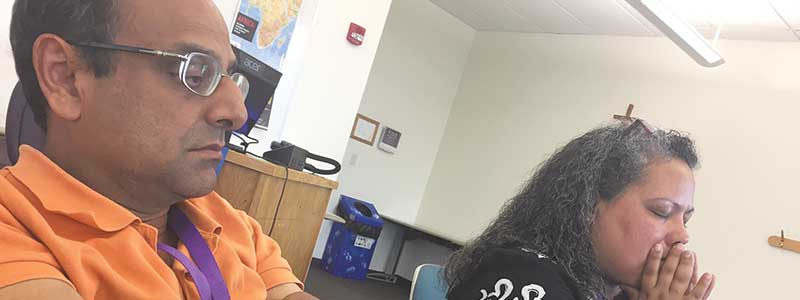
I am concerned that it is happening too late for some Friends of color. Many of us are wounded and exhausted and not wanting to travel on this journey with our meetings.
In order to begin a journey of healing our trauma from racism, it will be important for us to know and understand our own individual cultural heritage. We also need to have an honest understanding of how our ancestors contributed to this world and undergirded the structure of white supremacy. Also, we need to understand how we continue to maintain vestiges of this structure in our behaviors today. It is only possible to change a system once you have a clear understanding of how it operates. Acknowledging the pain and celebrating the accomplishments will help us be able to transform members of our religious communities and eventually the inhabitants of the world into peaceful human beings.
I feel that the Religious Society of Friends is at a crisis point. I am excited that many meetings are taking on the task of examining and addressing their white supremacy behaviors, yet I am concerned that it is happening too late for some Friends of color. Many of us are wounded and exhausted and not wanting to travel on this journey with our meetings. I have to say that we are not alone. Black Unitarian Universalists and Evangelicals are also leaving their predominantly white churches. The March 9, 2018, issue of the New York Times had an article titled “At the Crossroads of Church and Race,” written by Campbell Robertson:
Pastors, theologians and sociologists were talking of how black worshipers were leaving white-majority churches. They were leaving quietly and not en masse, a family here, a single person there. But it was happening everywhere, a movement large enough for some to see the unraveling of decades of efforts at racial reconciliation.
Chanequa Walker-Barnes, a professor of practical theology at the McAfee School of Theology at Mercer University in Atlanta, is quoted in the article as saying, “It said, to me, that something is profoundly wrong at the heart of the white church.”
In the fall of 2017, the Black Lives of Unitarian Universalism (BLUU) conducted a survey of Black Unitarian Universalists. Some of the core findings from the survey were the following:
- Black UUs feel a deep sense of isolation and rely heavily on social media, particularly the Black Lives of Unitarian Universalism closed Facebook group, to connect with other Black UUs.
- Black people tend to become a part of UU congregations because of their theology, not because of the community. White dominant culture gets in the way of their communal experience and serves as an exclusionary force in church life, simply put: Black people, when they show up in ways that are culturally divergent from white, middle- and upper-class culture, do not feel welcomed.
- The meet-ups, online worship services, daily affirmations, and pastoral care that make up the BLUU Ministerial Network (BLUUMin) programming is deeply meaningful and sufficient for the majority of survey participants, and also folks are hopeful for an expansion of these offerings that involve more advertising of the programming, face-to-face gatherings, small group ministry, and opportunities for youth/young adult leadership.
- The vast majority of people feel like organizing from a faith perspective with other Black UUs would be beneficial to them and their UU communities.
What is causing African Americans to feel isolated in both the evangelical and non-evangelical churches and meetings? In the words of Deborah Jian Lee from her article “Betrayed at the Polls, Evangelicals of Color Caught at a Crossroads”:
We must contend with a dominant white theology, shaped in the cauldron of privilege, [and white supremacy] which suggests that a successful life springs from an individual’s good, moral choices alone. It fails to recognize how unfair policies and societal structures harm the economic, [spiritual] and social well-being of those subject to those systems.
Are we ready to make the systematic changes necessary in our meetings to remove white supremacy?
Quakerism continues to maintain structures and practices that reinforce patterns of racial exclusion through white supremacy. It is difficult enough for people of color to navigate these barriers in everyday life. Many are deciding to no longer support religious communities that do not understand or seek to recognize these barriers. African American Friends do not feel welcome in the Religious Society of Friends because we have been speaking about these barriers and the importance of their removal for centuries, seemingly to deaf ears. Are we ready to make the systematic changes necessary in our meetings to remove white supremacy?
If not, a racially diverse Religious Society of Friends in the United States of America will come at great cost to the Friends of color who remain, if it comes at all.


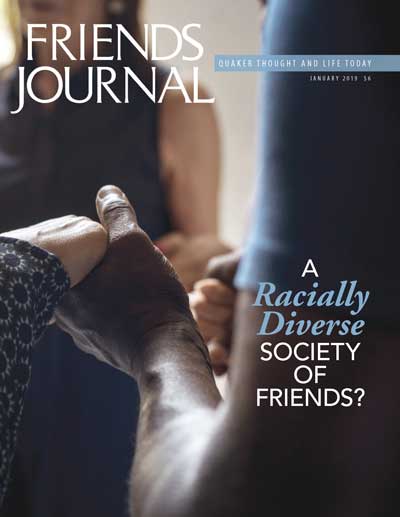
Wow! Wow. Nothing could be clearer than the history you give here and in your 2009 book. I appreciate the later links as well. I continue to be humbled by the persistence of Quakers of color I know–mostly African-American adults–to partake of a faith that has been so insulting and inhuman in its religious practice–i.e, in conformity with the main stream. There is a soul in Quaker faith and practice that wants to survive this, and even survive the comfort that leads to betrayal of faith. As you ask and comment: ” What happened to the Religious Society of Friends that we could choose to hide our passions? One of our standing jokes may supply the answer: They came to do good and did quite well. Yes, personal perspectives on justice have been known to change with one’s degree of comfort.” That’s it, over and over–comfort trumps courage.
I think “the collective we” will never be able to say yes to your final question. And the overwhelming weight of the mountain that must be moved if we are to change and survive, may mean those who answer yes need to move away from the mountain, and make a smaller hill with the strength to live the heart of our faith. John Woolman prayed publically for his contemporaneous who were slave-owners, trying to impress upon them that they were condemning their own souls by such evil. Do we believe in the soul?
For white Friends like me, seeing systemic or institutional racism in our religious tradition requires someone to lay out the seemingly isolated incidents, draw lines and ties between them, and point out the repetitive pattern in plain speech. Vanessa, you do this powerfully and effectively. Will we white Friends in the U.S. respond systemically and not just individually…?
Thank you for a very clear identification of the issue of while supremacy which a liberal church like the one I serve, the Episcopal Church, tends to think has already been dealt with. Rather it is the iceberg under the surface of our ‘All are Welcome’ self talk that causes people of color to seek other places of worship where they don’t encounter the all to real for them, racism in our spiritual communities.
Much deeper, harder, work is needed, with a willingness to confront truths we would rather avoid.
Well written Vanessa. I am inspired by your ministry and have experienced at San Francisco Monthly Meeting that these transformations – though it can be a frustrating period of clock-time – can take place.
I celebrate this discussion and am interested and curious to hear more about the specific behaviors that show these patterns of racial exclusion and what other types of behaviors and systemic structures that Quakers have acquiesced to that also reflect white supremacy, and the dominant culture? How has it been, what has been the harms and how can they be addressed and what are the dreams for how things could be different going forward? Let’s bring out the laundry lists, please!! 😉 I look forward to seeing these terms defined more specifically. It is through dialogue that I am hopeful awareness building and consequently, change can happen. I am hopeful that meetings become ever more resourced to be in a space of dialogue, that spirit of cultivating understanding rather than denial or fear based, judgmental, and/or oppressive choices or structures (or non-structure) where there is no space for dialogue. How can we be more in our full prefrontal cortex and engage our highest level of thinking to learn and grow together? Who are the peacemakers in meeting? What is needed to be ready to make the systematic changes necessary to meetings? What are the systematic changes that are necessary or desired? What resources are available to support systematic change in Quaker meetings? What are the current systems and how do they operate and what system(s) would/could replace them?
I wonder if the healing of Quaker racism can be accomplished without White Quakers being willing to follow Black Friends who seek out worship communities, whether Quaker or not, that are truly diverse, welcoming, and willing to adapt to the needs of all their congregants.
As a White Friend, I must confess that I have attended majority or entirely Black worship services, but in a spirit of what I call religious tourism, rather than honest spiritual quest. I tend to think I am paying churches that do not look like me a compliment by attending their worship every year or two.
Reading Will Willimon’s Who Lynched Willie Earle and Cornel West’s Democracy Matters have convinced me that I must stop observing the religion of the oppressed and cast my whole lot with the oppressed, if I am to be rid of my racist cancer. So I attended a local CME Church near my home this past Sunday and intend to do so again, again, and again until I can worship as a part, rather than a guest. I want to be taught by them what true spiritual worship is because true religion in the prophetic tradition grows up from, rather than reaching down to the oppressed.
My membership with Friends, if that can persist with the full consent of my Monthly Meeting, will likely consist in my participation in non First Day activities and functions, such as committees, study groups, or community service.
It strikes me that white supremacy has an individual level and a societal level, and I suspect different strategies are appropriate for each level.
How can individual Friends and monthly meetings act to reduce/delete white supremacy on a societal level? Political action seems like the most effective approach, and I believe FNCL and other state-based advocacy groups are active on this front, and are supported by many Friends, meetings and churches.
How to act on an individual level? Here, there are 2 cases: one to one interactions, and interactions between an individual and a meeting committee or meeting for business.
In case 1, is it true that rude or terminally tactless Friends are categorically more burdensome for black Friends than for Friends in general? I can only say that I, a white person, have occasionally felt mistreated by other Friends. I tend to think that perceptions of offense vary widely among all kinds of individuals, so I am wary of generalizations that black Friends are always more put upon by rude Friends than are Friends in general.
In case 2, is it true that unhelpful decisions or tactless behaviors by Friends committees are categorically more burdensome for black Friends than for Friends in general? Again, I tend to think that perceptions of offense vary widely among all kinds of individuals, so I am wary of generalizations that black Friends are always more put upon by impolite or unhelpful committees than are Friends in general.
I have always attended and participated in events and groups that I found interesting or informative for various reasons and for varying durations. I totally support all Friends in participating as benefits them as individuals, and I hope all Friends will empower themselves to act in their own best interests, whether that means speaking up, remaining silent, or departing.
When I have spoken up once or twice, I have not gotten much support, in large part I think because many Friends don’t like conflict and confrontation. So far, the benefits for me outweigh the drawbacks. And if that ever changes, well, it’s a big world and there are many people, groups, and places I have yet to explore.
One recipe to help Friends who are feeling conflicted, that may help clarify communication when threshing these issues is the Nonviolent Communication recipe:
1. Observations as in statements about specific, observable words and/or actions
2. Feelings as in “I” statements about these words/actions
3. Needs as in stating my needs and the specific ways my needs are not being met
4. Requests as in stating specific words/actions that would meet my needs
what happened to the comments that were here?
Update: the missing comments have been restored here and site-wide.
I am curious: when someone notices that non-white Friends have stopped attending, does anyone attempt to reach out to them? When I have stopped attending an organization, if nobody asks why, then I interpret that as lack of interest. Did I sever the relationship for a personal issue (e.g. physically moved away) or a “fit” issue – I do not fit in that place? Employers often have Exit Interviews of departing employees, to learn if they can improve conditions to better retain employees. Wouldn’t this be a good policy for Friends Meeting?